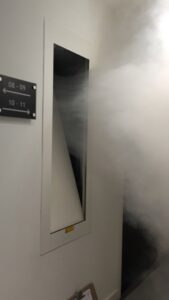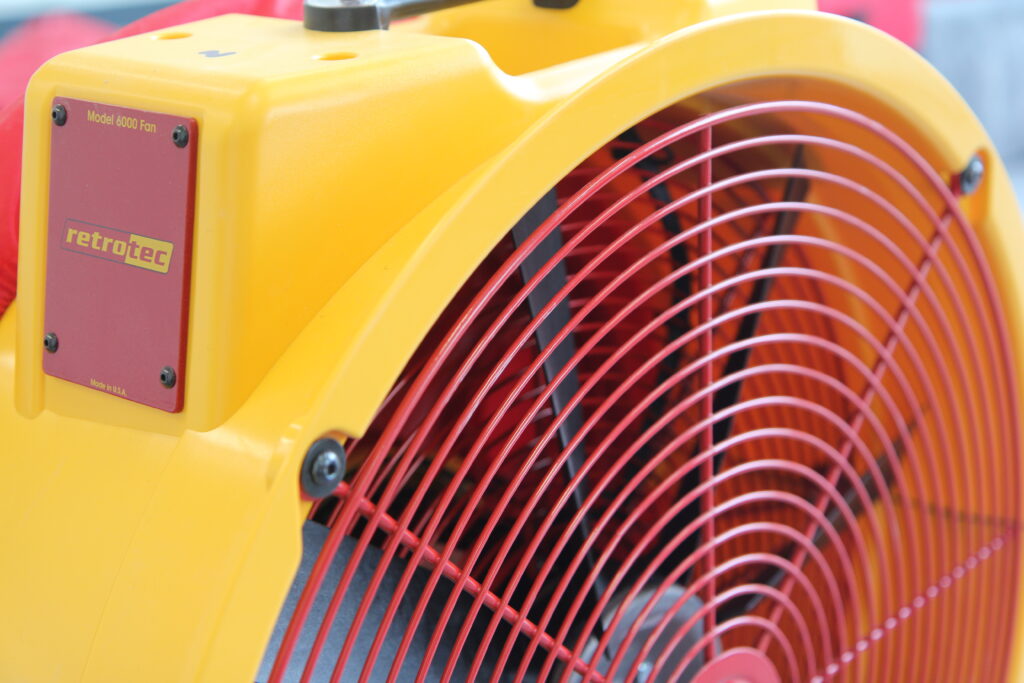Smoke shafts are an important part of a building’s fire strategy and are now commonly designed into multi-story commercial and residential buildings.
Smoke shafts can save lives. In the event of a fire, their purpose is to vent smoke from corridors, stairwells, and other common areas. This in turn increases visibility and reduces some of the dangers of smoke inhalation. To ensure shafts extract smoke effectively, we need to demonstrate that the shafts are airtight, and we can do this with a smoke shaft test.
Air tightness specifications
Most smoke shafts are designed to be below the leakage rate of 3.8m3/hr/m2 at 50 Pa, which is the Colt recommendation and now the industry standard. These do differ on some projects though, so it is important that you have a confirmation of the specification before works begin.
Smaller envelope areas generally deliver a more ‘leaky’ air-tightness test, and smoke shafts can have a very small envelope area. As a result, smoke shafts are at a very high risk of failure, so an effective air-tightness strategy must be in place during each stage of construction.
If the air test shows that the shaft fails to meet the requirements, remedial work inside the shaft is most commonly the solution. This can become very complicated and costly due to the restricted size of the working area, which often requires rope access and even Confined Space Training. Due to the remedial sealing logistics often presenting significant problems, it is recommended that consultancy advice is sought at an early stage, which we can provide.
Smoke shaft testing process
Air tightness testing for a smoke shaft is very similar to a standard building air permeability test, but the complications for diagnostics mean it will benefit from a more experienced testing engineer.
As with a building test, the shaft is tested using a calibrated fan that can fit into one of the openings. The best approach is to test when the shaft is complete and the Automatic Opening Vents (AOVs) are temporarily sealed using tape, Corex or Celotex, rather than relying on dampers. These are best sealed from the inside, so you may benefit from not having the AOVs installed at the time of the test.
 When it comes to diagnosing failures, access to the inside of the shaft is not possible, so the use of smoke generating machines is required to help identify the more significant problem areas.
When it comes to diagnosing failures, access to the inside of the shaft is not possible, so the use of smoke generating machines is required to help identify the more significant problem areas.
Strategies for air tight smoke shafts
So how do we get the required level of air tightness? As shafts are at such a high risk of failure, you should seek the advice of experienced consultants early on in the process.
Regardless of the building materials, the best approach is often to treat the inside of the shaft as the primary air seal line. As such, the finish inside should be smooth and conscientiously sealed at all junctions and joints.
If there is an internal plasterboard finish, this needs to be sealed thoroughly across every joint and screwhead, again paying attention to all junctions and penetrations.
If there is any ductwork or structural materials penetrating the inside line of the shaft, you will need to instruct each contractor on the importance of having a good and continuous seal, paying particular attention to areas that are going to be hard to reach after installation e.g. when a steel support may be flush against a wall junction.
The frames or architraves around the AOV openings often present a leakage path for air, and so should be mastic sealed across the entire perimeter on the inside of the shaft.
Cable penetrations should be sealed effectively throughout the construction, with a proactive approach encouraged of all contractors carrying out the works. This is especially important in small smoke shafts. Large bunches of penetrating cables should be discouraged in favour of having a separate penetration for each cable. This approach will enable a good seal to be created with the application of mastic.
Any cable penetrations behind electrics fittings and control panels need to be effectively sealed before the panel is closed. Make sure that any installation contractors are aware of the importance of this, as a call-out to remedy this can be costly and time-consuming.
For conduits, as well as sealing around where they penetrate the wall, it is best practice to seal them inside too. This can be done by opening the conduit where it penetrates the wall for the best effect.
Do you need help with Smoke Shaft Testing?
Call us on 0330 055 34 05 or email be@buildenergy.co.uk.
